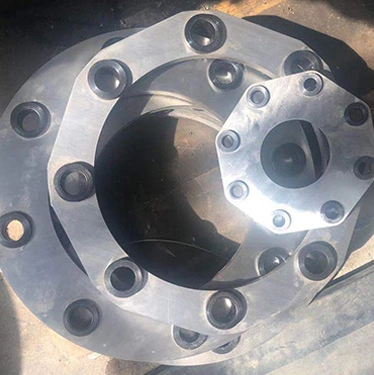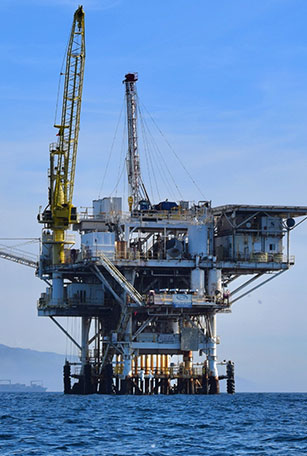
The thickness of the stainless steel diaphragm is generally 0.2mm to 0.6mm, and the material is 304 stainless steel. The diaphragm shapes mainly include ring type, spoke type, connecting rod type, multilateral type and waist type. The all-stainless steel diaphragm consists of several groups of diaphragms (stainless steel sheets) that are interactively connected with the two halves of the coupling with bolts. Each group of diaphragms is composed of several stacked pieces. Elastic deformation is used to compensate the relative displacement of the connected two shafts, no lubricating oil is required, the structure is relatively compact, the service life is long, there is no rotation gap, it is not affected by temperature and oil pollution, it has the characteristics of acid and alkali resistance, and is suitable for high temperature, high speed, shaft transmission in environment with corrosive media. The all-stainless steel diaphragm is fastened to the shaft sleeve with pins and generally will not loosen or cause backlash between the diaphragm and the shaft sleeve. Some manufacturers offer two diaphragms or three diaphragms with one or two rigid elements in the middle, and the two sides are connected to the bushing. The difference between a single-diaphragm coupling and a double-diaphragm coupling is the ability to handle various deviations. In view of the complex bending of the diaphragm, the single-diaphragm coupling is not suitable for eccentricity. The double-diaphragm coupling can be bent in different directions at the same time to compensate for eccentricity.
The structure of metal diaphragm flexible coupling is mainly composed of metal diaphragm group (diaphragm), half coupling, intermediate section, compression element, bolt, locknut, washer, etc. The working principle is: the torque is input from the half-coupling at the driving end, and the torque is transmitted to the diaphragm group through the main transmission torsion bolts arranged at intervals along the circumference, and then the diaphragm group is transmitted to the intermediate section through the bolts, and also output by the diaphragm group, bolts and half-coupling. The metal diaphragm is the key component of the flexible coupling. It consists of a number of thin metal diaphragms stacked to form a diaphragm group, through which torque and motion are transmitted.
The diaphragm of the coupling is mainly subjected to three forces, the axial thrust given to it by the main shaft of the unit, the film stress and the inertial centrifugal stress generated by the rotational torque of the steam turbine. The diaphragm is an elastic diaphragm, and the axial thrust will not have a destructive effect on it. Membrane stress and inertial centrifugal stress due to torque.
1. Membrane stress caused by torque. Let the transmitted torque be T, the total number of pieces be m, the number of bolt holes be n, and the diaphragm radius be r. From the simplified conditions, it is known that the force on each main bolt is F=T/nmr. It can be seen that under the same conditions, the force on the diaphragm is inversely proportional to the number of sheets and the number of bolt holes. The four-hole diaphragm coupling is much more stressed than the hole, and it is bound to be easily damaged.
2. The transverse stiffness of the coupling can be obtained by fitting the experimental data: four-bolt diaphragm: K=2000N/m; six-bolt diaphragm: K=3000N/mo. It can be seen that the stiffness of the six-bolt hole diaphragm is better than Four-bolt hole diaphragm, and stiffness is also an important factor affecting the long-term operation of the diaphragm coupling.
3. Centrifugal stress generated by inertia
The simplified mechanical model of the coupling is a spring-mass system with two degrees of freedom. Calculation of the first-order critical speed frequency of the coupling. There are two factors that affect the critical speed of the coupling, one is the stiffness of the diaphragm, and the other is the mass of the intermediate section, which is proportional to the stiffness of the diaphragm and inversely proportional to the mass of the intermediate section. In the implementation, the weight of the middle section of the coupling remains unchanged, which is 3kg. Substituting the obtained stiffness data into the formula, the critical speed of the four-bolt coupling is 50.3Hz, and the critical speed of the six-bolt coupling is 75.5Hz. Six-bolt couplings can withstand higher critical speeds than four-bolt couplings. The centrifugal stress can be loaded according to the radial force F=(2n/60)2rp. According to the previous calculation of the critical speed, the critical speed of the four-bolt diaphragm is 50.3Hz, that is, 3018r/min. Working at a speed of 4250r/min causes the inertial centrifugal stress to exceed the bearing capacity, resulting in excessive deformation of the diaphragm, which in turn intensifies the radial and angular Other stresses such as deflection force cause huge impact damage to the coupling diaphragm.
0531-69959201
lqg18653457231
+86-18653457231
No 12111,Jingshi Road, Lixia District, Jinan City, Shandong Province. P.R. China

Professional customer service team, professional after-sale services create a comprehensive high-quality, advanced technology, reliable products, which gives you a strong sense of security.

Professionals, professional skills and precision equipments insure that we can provide you with professional product customization service.

The best quality products, strict quality control system and good reputations established Saigao product's irreplaceable place.

Superb technical team with continuous technological innovation, closely follow the market's trend help you to create the highest performance products.
 English
English  日本語
日本語  français
français  Español
Español  русский
русский  português
português  العربية
العربية  tiếng việt
tiếng việt  ไทย
ไทย  Polska
Polska  română
română 

